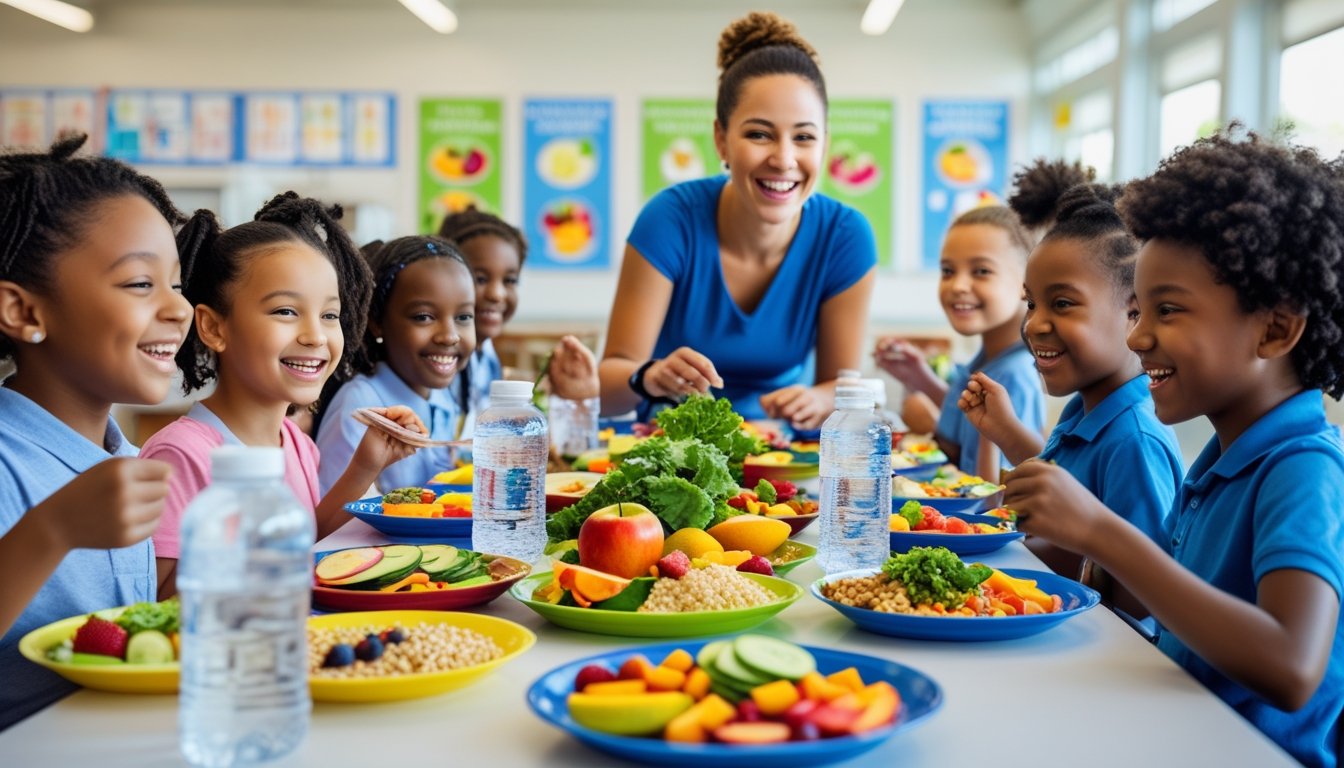Late updated: 12 Aug 2025 11:08
Written by:
Encouraging Healthy Eating Habits For School Children: Effective Strategies and Tips
Encouraging healthy eating habits for school children is vital to their growth, academic performance, and long-term health. Providing children access to nutritious meals ensures they receive the essential nutrients their bodies and minds need. We, as caregivers and educators, play a pivotal role in shaping these eating habits. By actively engaging in children's food choices and promoting balanced diets, we set a foundation for lifelong healthy behaviours.

Children spend a significant part of their day at school, making it an ideal environment to reinforce healthy eating practices. Our involvement can include advocating for nutritious school meal programmes and incorporating educational activities around food nutrition. These efforts help children appreciate the value of healthy eating and make informed choices outside of school.
To effectively encourage these habits, we should employ strategies that make the process enjoyable and interactive. Involving children in meal planning and preparation can ignite their interest in healthy foods. These small steps not only foster positive relationships with food but also empower children to make better choices for themselves.
Key Takeaways
- Active involvement in children's food choices is crucial.
- Nutritious school meals boost academic and health outcomes.
- Engaging children in meal preparation fosters healthy habits.
Core Strategies for Encouraging Healthy Eating Habits
Influencing children’s dietary choices demands a combination of nurturing, involvement, and structured routines. Encouraging them to make sound food choices, fostering meal traditions, limiting sugary beverages, and integrating them into meal preparations are key steps.
Guiding Children Towards Healthy Food Choices
We can guide children towards healthier food choices by introducing diverse foods in a fun and engaging manner. Encouraging them to try different fruits, vegetables, and whole grains helps expand their palate. Discussions about the benefits of these foods emphasise the importance of nutrition. Visual aids, like charts linking foods to nutrients, can make these concepts relatable. By involving children in selecting vegetables or fruits during shopping, we reinforce their interest and decision-making skills.
Role-modelling by parents and teachers plays a significant part. Children are more likely to imitate eating habits they observe. Celebrate small victories when new foods are accepted. Offering rewards for adventurous eating can encourage further exploration without resorting to sweets as incentives.
Promoting Family Mealtimes and Routines
Establishing regular family meals provides opportunities to reinforce healthy eating habits. We can make mealtimes pleasant by engaging in conversation and minimising screen distractions. Consistency in meal times helps children develop a routine and reduces the likelihood of skipping meals. Shared meal preparation, from choosing recipes to setting the table, creates a sense of inclusion.
Family meals are an avenue to demonstrate portion control and balanced meals. Discussing the structure of a nutritious plate—such as half vegetables, a quarter protein, and a quarter whole grains—grounds these ideas in daily life. Creating themed nights, such as veggie pizza night, adds excitement and encourages involvement from all family members.
Reducing Sugar-Sweetened Drinks and Unhealthy Snacks
Limiting sugar-sweetened drinks and unhealthy snacks is crucial. Replacing these with healthier alternatives like water, milk, or homemade fruit smoothies reduces unnecessary sugar intake. We can also provide healthier snack options such as nuts, fruits, and wholegrain crackers. Demonstrating and explaining the sugar content in sugary drinks using visual representation can be effective.
Encouraging children to drink water more frequently by having easy access to water bottles is beneficial. Keeping sugary treats for special occasions rather than a daily occurrence helps shift the focus from sugar-laden options. Our efforts to educate children about the long-term effects of sugar on their health can help them make informed choices.
Involving Children in Meal Planning and Preparation
Involving children in meal planning and preparation boosts their interest in healthy eating. Allowing them to choose recipes from a selection of healthy options fosters a sense of ownership. Younger children can assist with simple tasks like washing vegetables, while older ones may enjoy more complex activities like measuring ingredients.
As we engage them in cooking, we also have the chance to discuss nutritious ingredients and their benefits. Exploring different cuisines introduces new tastes and broadens their culinary experiences. Cooking together can be a fun learning experience that promotes creativity and helps them develop essential life skills.
Practical Approaches to Supporting Healthy Eating at School

Encouraging healthy eating habits in schools requires practical measures that ensure children have access to nutritious meals and snacks. These measures promote understanding of healthy portions and educate students about food choices and nutrition.
Incorporating Nutritious Foods Into School Meals
Schools must strive to include a wide range of nutritious foods in their meal plans. Diverse menus featuring fruits, vegetables, whole grains, and lean proteins can make a significant difference. We need to engage with local suppliers to source fresh produce, ensuring meals are both healthy and appealing.
Menu planning should consider students' tastes while introducing new and nutritious options. Taste tests can help determine which healthy items resonate with students, making it easier to adjust menus accordingly. Creative presentations can enhance the meal experience, encouraging students to try and enjoy healthy dishes.
Encouraging Healthy Snacks and Portion Control
Promoting healthy snacks involves making smart choices easily accessible. Offering options like fruits, nuts, and yoghurt can satisfy hunger without compromising nutrition. Establishing guidelines for portion sizes helps students understand the importance of moderation.
Through classroom activities, we can educate children about choosing balanced snacks. Visual cues, such as portion plates, can guide students in understanding how much food is appropriate, reinforcing healthy habits. Partnering with parents to align school and home habits strengthens these concepts, creating consistency in children's nutrition choices.
Fostering Nutrition Education and Food Label Awareness
Education is a vital tool to ingrain healthy eating habits. Teaching students to read and understand food labels equips them with the skills to make informed choices. Lessons can cover identifying key components like calories, fats, and sugars, fostering a critical approach to nutrition.
Interactive sessions and workshops can make nutrition learning engaging. Encouraging students to participate actively, such as through school gardening clubs, connects them with food sources directly. This engagement not only builds knowledge but also sparks interest in trying new, healthy foods, contributing significantly to their overall personal development.
Frequently Asked Questions

Our focus is on cultivating healthy eating habits in school children through strategic initiatives and collaboration between schools and parents. Engaging activities and nutritional education are key components in promoting lifelong healthy eating habits.
What strategies can schools implement to promote healthy eating among students?
Schools can incorporate healthier menus and provide access to varied, nutrient-rich meals. Participation in national child nutrition programmes ensures a regular supply of fruits, vegetables, and whole grains. Creating a supportive atmosphere that limits weight-based teasing and encourages positive conversations about food is essential.
How can teachers incorporate nutrition education into their classroom activities?
Teachers have an array of options to weave nutrition into their lessons creatively. They might use storytelling to introduce different food groups or utilise interactive activities like cooking classes to reinforce healthy eating messages. Inviting nutrition experts to speak to students is another effective method to impart valuable dietary knowledge.
What are some effective ways to encourage children to make healthy food choices?
We can motivate healthy choices by involving children in meal preparation and planning, which increases their enthusiasm and buy-in. Positive reinforcement, such as verbal praise, can effectively promote beneficial eating habits. Schools and parents alike should aim to model healthy eating behaviours.
What role does a balanced diet play in the growth and development of children aged 5 to 12?
A balanced diet is crucial for children's physical and cognitive development. It fuels their growth, supports essential bodily functions, and boosts concentration and learning abilities. Ensuring an intake of all necessary nutrients helps lay a strong foundation for healthy adolescent and adult life.
How can parents and schools work together to ensure children develop healthy eating habits?
Collaboration between parents and schools is key to promoting healthy eating. Schools should communicate effectively with families about the nutrition policies and meals offered. Parents can reinforce these habits at home by setting a good example and planning meals that include a variety of food groups.
What are some creative healthy eating activities that can be included in school curriculums?
Interactive activities such as "food science experiments" can excite students about nutrition. Garden-based learning offers hands-on opportunities for children to grow and taste their own produce. Incorporating cooking demonstrations and involving students in creating healthy recipes can transform theoretical knowledge into tangible experience.
